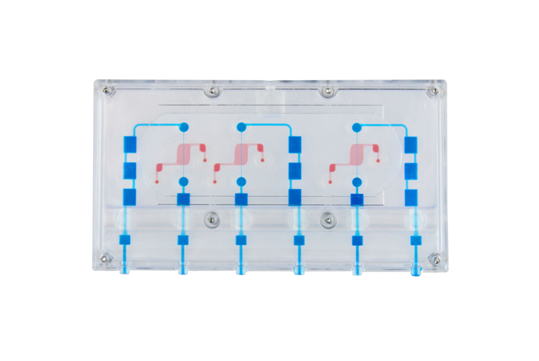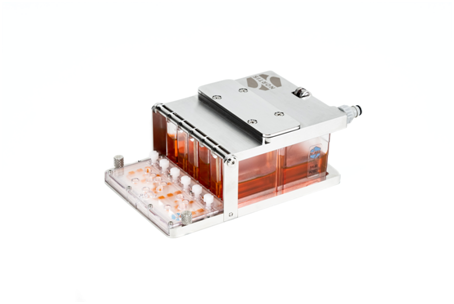By Evercyte GmbH
Evercyte immortalized cell lines compatible with OOAC organ on chip technology
Evercyte offers a very wide range of immortalized cells that can be embedded in human organ-representative microenvironments using organ-on-a chip (OOAC) technology.
Evercyte has proved compatibility in a collaboration with OOAC leader Nortis in which its RPTEC/TERT1 human renal proximal tubular epithelial cells were seeded into ParVivo™ Microfluidic Chips to provide a self-contained plug-and-play approach to OOAC modeling.
By combining its extensive range of human telomerized cells with this emerging technology, Evercyte is promoting animal-free drug screening that is also more predictable, patient-relevant, faster and lower cost.
OOAC advantages
OOAC organ-on-chip technology, also known as a microphysiological system (MPS), creates in vitro tissue models, including appropriate microenvironment and microfluidic flows, which mimic human organ functionality and that are compatible with in-silico analysis. By providing a dynamic and IT-connected biological test platform, the OOAC model offers a potentially game-changing approach to non-animal biological testing in academic research and drug discovery.
OOAC particularly addresses long-standing problems with conventional approaches, including animal-based in vivo models and simpler ‘2D’ plate-based in vitro models, which both have limitations.
- Animal testing, although indicating actual in vivo drug responses, often fails to accurately predict drug-induced toxicity and treatment efficiency in humans.
- Traditional 2D models offer cost-effective solutions but are less able to model the complexity of native tissue structures and systemic physiological processes.
OOAC applications
The micro-engineered OOAC platform, made possible by advancements in microfabrication technology and microfluidics, addresses these limitations by replicating the in vivo structures and functions of human organs. By connecting multiple organs and tissue models, it enables the emulation of complex organ-organ interactions, allowing for a more comprehensive study of drug metabolism and pharmacokinetics, with superior prediction capability, reduced duration, cost and complexity, while also addressing ethical considerations and the ‘Three Rs (Replace, Reduce, Refine)’ ideal.
Thus, OOAC technology has the potential to revolutionize drug target identification and validation studies without the need for animal models, with enhanced patient specificity and precision and faster, cheaper workflows that can improve drug screening efficacy, safety, and cost-effectiveness.
OOAC Potential
Evercyte’s extensive portfolio includes immortalized cells derived from different human primary tissues such as lung fibroblasts, umbilical vein endothelial cells, renal proximal tubular epithelial cells, and MSCs derived from bone marrow, adipose tissue, placenta and dental pulp.
These cells have been established by ectopic expression of the human telomerase, to provide high similarities with primary cell function and behaviour, but with much longer cellular life span, stable growth rates and karyotype. Immortalized cells are capable of infinite proliferation, readily available, genetically identical, and easy to culture over time and characterized by morphology, phenotype and functions that mimic their parental primary cells.
These characteristics make Evercyte ‘telomerized’ cells highly applicable to OOAC systems such as the industry leading Nortis ParVivo™ platform.
ParVivo™ technology
Evercyte has collaborated with Nortis, a world leader in the development of pre-seeded microfluidic chips that provide a self-contained ready-to-test approach to OOAC modeling. Its ParVivo™ Microfluidic Chips model a variety of human tissue structures such as the kidney proximal tubule and can be simultaneously perfused with culture media using the ParVivo™ Perfusion System.
Evercyte provided its RPTEC/TERT1 human renal proximal tubular epithelial cell line to be seeded into ParVivo™ Chips. These cells could be passaged numerous times while maintaining the expression of certain markers and desired morphology which are logistically and scientifically important aspects to a robust OOAC model. The cells adhere to the collagen 1 matrices within each chip and form human kidney proximal tubule tissue segments. The tissues are perfusable and surrounded by a biologically relevant matrix, recreating the critical in vivo elements of fluid flow and physiological polarity while avoiding contact with inorganic surfaces.
Combining RPTEC/TERT with ParVivo™
Evercyte RPTEC/TERT1 human renal proximal tubular epithelial tissue chips can be used to study cellular uptake and transport, test for toxicity, various biomarker responses and more. Researchers can easily introduce drugs or other compounds and measure responses in this human-relevant model. As the kidney proximal tubule is particularly prone to toxicity risk, the combination of the RPTEC/TERT1 cell line and OOAC technology offers a powerful tool to preclinical researchers. Additionally, the cell line is an ideal starting material for genetic engineering to create important disease models.
Evercyte’s embrace of OOAC technology, combining the highly modular Nortis platform with its immortalized human cell lines represents a major milestone in the field of drug development and promises to accelerate the discovery of safe and effective drugs, ultimately benefiting patients worldwide.
Resources
Click on Evercyte Kidney RPTEC/TERT1 cell line for further information.
Click on Evercyte cells catalogued by tissue body fluid for further information.
Click on Evercyte cells catalogued by cell type for further information.
Click on Testing for renal tubular nephrotoxicity using OOAC technology to learn more.
Click on Nortis Bio Microfluidic Chips to learn more about ParVivo™ technology.





















